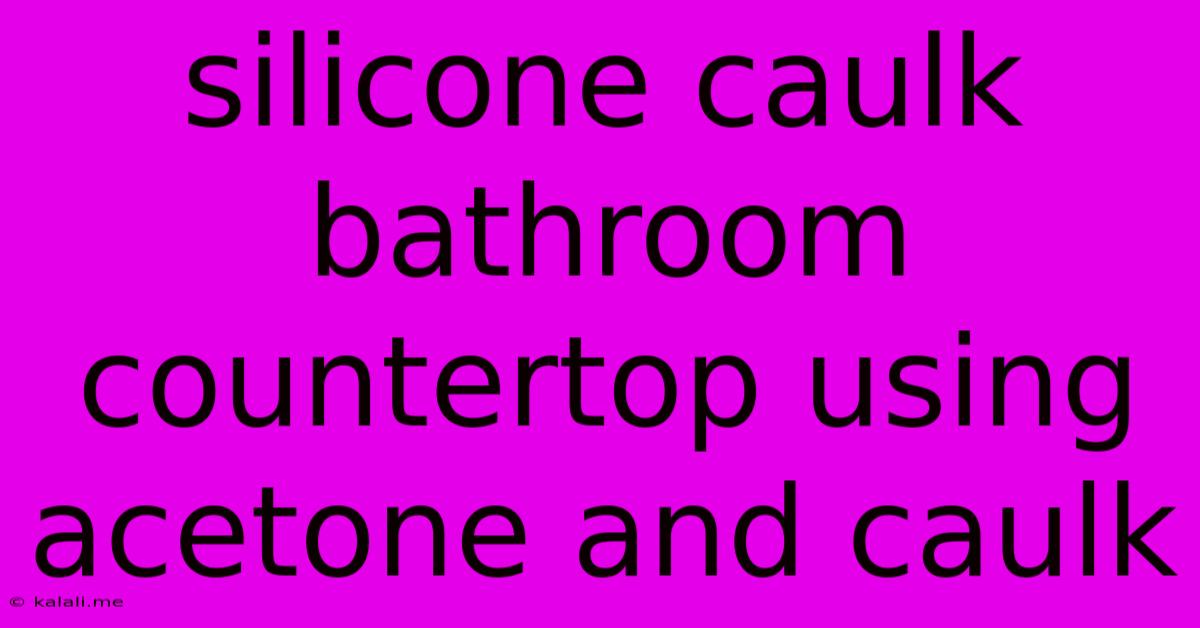Silicone Caulk Bathroom Countertop Using Acetone And Caulk
Kalali
Jun 03, 2025 · 3 min read

Table of Contents
Removing Silicone Caulk from Bathroom Countertops: An Acetone-Based Approach
Meta Description: Learn how to effectively remove stubborn silicone caulk from your bathroom countertop using acetone. This guide provides a step-by-step process, safety precautions, and tips for a clean, professional finish.
Silicone caulk is a common sealant used in bathrooms, providing a watertight barrier between countertops and sinks, tubs, or shower walls. However, over time, caulk can become discolored, mildewed, or simply unsightly, requiring removal and replacement. While several methods exist, using acetone offers a relatively quick and effective solution for removing silicone caulk from bathroom countertops. This guide will walk you through the process, emphasizing safety and achieving a clean finish.
Understanding the Materials: Acetone and Caulk
Before we begin, it's crucial to understand the materials involved. Acetone is a powerful solvent that effectively dissolves silicone caulk. However, it's also highly flammable and volatile, requiring careful handling. Always work in a well-ventilated area, away from open flames or sparks.
The type of caulk you're removing also matters. This guide focuses on silicone caulk, which is commonly used in bathrooms due to its water resistance. Other types of caulk may require different removal methods.
Step-by-Step Guide to Removing Silicone Caulk with Acetone
1. Preparation is Key:
- Protect the surrounding area: Cover the countertop around the caulk line with painter's tape and plastic sheeting to prevent acetone damage. This is crucial to protect your countertop's finish.
- Gather your tools: You'll need acetone, a plastic scraper (or a putty knife), several clean cloths, safety glasses, and rubber gloves.
2. Applying the Acetone:
- Soak the caulk: Using a cotton swab or small paintbrush, liberally apply acetone to the silicone caulk line. Allow it to sit for several minutes to soften the caulk. The amount of time needed will depend on the age and type of caulk.
- Multiple applications may be necessary: For older, stubborn caulk, you may need to repeat this process several times, allowing the acetone to penetrate and break down the sealant.
3. Removing the Softened Caulk:
- Gentle scraping: Using a plastic scraper or putty knife, carefully scrape away the softened silicone caulk. Avoid applying excessive pressure to prevent scratching the countertop. Work slowly and methodically.
- Multiple passes: You may need to make several passes to completely remove all the caulk. Wipe the scraper frequently with a clean cloth to remove residue.
4. Cleaning and Finishing:
- Acetone residue removal: After removing the caulk, thoroughly wipe the area with a clean cloth dampened with acetone to remove any remaining residue.
- Final cleaning: Once all the caulk and acetone residue are removed, clean the area with a suitable countertop cleaner. Refer to your countertop's manufacturer instructions for cleaning recommendations.
5. Applying New Caulk (Optional):
After cleaning, you can apply new silicone caulk. Ensure the surface is clean and dry before applying the new sealant for a lasting bond.
Safety Precautions: Working with Acetone
- Ventilation is crucial: Always work in a well-ventilated area. Acetone fumes are hazardous and can cause dizziness and headaches.
- Wear protective gear: Always wear safety glasses and rubber gloves to protect your eyes and skin from acetone.
- Avoid open flames: Acetone is highly flammable. Keep it away from open flames or sparks.
- Proper disposal: Dispose of acetone and cleaning materials according to local regulations.
Tips for Success
- Test in an inconspicuous area: Before applying acetone to the entire caulk line, test it on a small, hidden area of your countertop to ensure it doesn't damage the surface.
- Patience is key: Removing silicone caulk can be time-consuming, especially for older, stubborn sealant. Take your time and work methodically.
- Consider alternative methods: If acetone proves ineffective or damages your countertop, consider using a caulk remover specifically designed for silicone caulk.
By following these steps and safety precautions, you can effectively remove silicone caulk from your bathroom countertop using acetone, leaving it clean and ready for new sealant. Remember to always prioritize safety and work in a well-ventilated area.
Latest Posts
Latest Posts
-
How Do You Say Slang In Spanish
Jun 05, 2025
-
Can You Come Back To Questions On Preview
Jun 05, 2025
-
How To Say The Boss In Spanish
Jun 05, 2025
-
Whay Is My Petite Potato Purple
Jun 05, 2025
-
Slam Lidar Scanner Compared To Mono Camera
Jun 05, 2025
Related Post
Thank you for visiting our website which covers about Silicone Caulk Bathroom Countertop Using Acetone And Caulk . We hope the information provided has been useful to you. Feel free to contact us if you have any questions or need further assistance. See you next time and don't miss to bookmark.